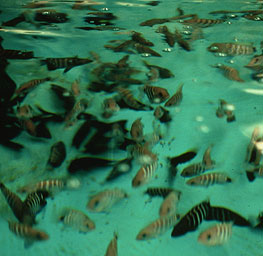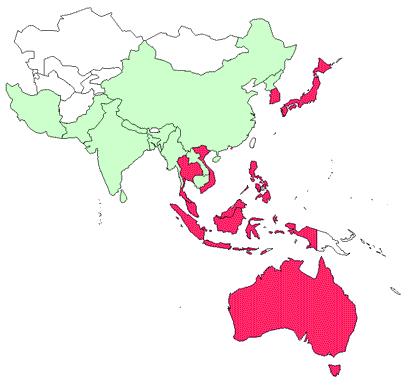Diseases of finfish
Viral diseases—Viral encephalopathy and retinopathy
(also known as viral nervous necrosis)
CLICK ON IMAGE TO ENLARGE

Source: B Munday
Signs of disease
Important: animals with disease may show one or more of the signs below, but disease may still be present in the absence of any signs.
Disease signs at the farm level
- 50% to 100% mortality over several weeks
Disease signs at the tank and pond level
- erratic, uncoordinated darting
- corkscrew swimming
- loss of equilibrium (resting belly-up)
- hyperactivity
- sporadic protrusion of head from water
- mortality of larvae
Clinical signs of disease in an infected animal
- colour change - affected barramundi become lighter, but grouper become darker
- overinflated swim bladder
- blindness resulting from lesions in eyes
- abrasions
- emaciation
- lethargy
Disease agent
Viral encephalopathy and retinopathy virus is a nodavirus formerly called barramundi picorna-like virus and striped jack nervous necrosis virus.
Host range
Fish known to be susceptible to viral encephalopathy and retinopathy:
Atlantic cod* (Gadus morhua)
Atlantic halibut* (Hippoglossus hippoglossus)
Australian bass* (Macquaria novemaculata)
barfin flounder* (Verasper moseri)
barramundi* (Lates calcarifer)
brown-marbled grouper* (Epinephelus fuscoguttatus)
cobia* (Rachycentron canadum)
common sole* (Solea solea)
estuary cod* (Epinephelus tauvina)
European eel* (Anguilla anguilla)
European seabass* (Dicentrarchus labrax)
flounders* (Paralichthyidae)
gilt-head seabream* (Sparus aurata)
greater amberjack* (Seriola dumerili)
grouper and estuary cod* (Epinephelus spp)
humpback grouper* (Cromileptes altivelis)
Japanese flounder, 'Hirame' strain* (Paralichthys olivaceus)
Japanese parrotfish* (Oplegnathus fasciatus)
Japanese puffer* (Takifugu rubripes)
Japanese seabass* (Lateolabrax japonicus)
longtooth grouper* (Epinephelus moara)
Malabar grouper* (Epinephelus malabaricus)
orange-spotted grouper* (Epinephelus coioides)
red drum* (Sciaenops ocellatus)
red snapper (Lutjanus erythropterus)
red-spotted grouper* (Epinephelus akaara)
seven-band grouper* (Epinephelus septemfasciatus)
shi drum* (Umbrina cirrosa)
silver trevally* (Pseudocaranx dentex)
striped trumpeter* (Latris lineata)
turbot* (Psetta maxima)
white seabass* (Atractoscion nobilis)
winter flounder* (Pseudopleuronectes americanus)
yellow-wax pompano* (Trachinotus falcatus)
Australian catfish (Cnidoglanis macrocephalus)
Barcoo grunter (Scortum barcoo)
golden perch (Macquaria ambigua)
Macquarie perch (Macquaria australasica)
Murray cod (Maccullochella peelii peelii)
samson fish (Seriola hippos)
silver perch (Bidyanus bidyanus)
sleepy cod (Oxyeleotris lineolatus)
* naturally susceptible (other species have been shown to be experimentally susceptible)
Presence in Asia–Pacific

Viral encephalopathy and retinopathy has been officially reported from Australia, Hong Kong, Indonesia, Japan, Malaysia, the Philippines, the Republic of Korea, Thailand and Vietnam. It is most virulent in barramundi (Lates calcarifer) and potentially other species of marine finfish, especially the groupers.
Epidemiology
- Viral encephalopathy and retinopathy has been found in more than 30 species of fish from 11 families, mainly in the Pacific.
- Virulence and mortality are age dependent (onset of clinical disease in younger fish of some species results in higher mortality).
- Batches of barramundi larvae for aquaculture are routinely screened for this disease.
- The incubation period for the disease in barramundi is four days, with onset about 9–28 days after hatching. In silver trevally, onset is one day after hatching.
- In barramundi, transmission is believed to be through the water column (ie via mouth, gills and skin). However, vertical transmission has been shown in silver trevally.
- In silver trevally, transmission from parent to offspring through eggs and sperm is known. However, it is believed that transmission may also occur through the water column.
- Mortality at one month is typically 50%–100% in barramundi and 100% in silver trevally.
Differential diagnosis
The differential diagnostic table and the list of similar diseases appearing at the bottom of each disease page refer only to the diseases covered by this field guide. Gross signs observed might well be representative of a wider range of diseases not included here. Therefore, these diagnostic aids should not be read as a guide to a definitive diagnosis, but rather as a tool to help identify the listed diseases that most closely account for the gross signs.
Sample collection
Because of uncertainty in differentiating diseases using only gross signs, and because some aquatic animal disease agents might pose a risk to humans, you should not try to collect samples unless you have been trained. Instead, you should phone your national hotline number and report your observations. If samples have to be collected, the agency taking the call will advise you on what you need to do. Local or district fisheries/veterinary authorities could advise you on sampling.
Emergency disease hotline
For your national emergency disease hotline number, see Whom to contact if you suspect a disease.
Further reading
http://www.oie.int/aac/eng/cards/en_diseasecard.htm
The currently accepted procedures for a conclusive diagnosis of VER are summarised at http://www.oie.int/eng/normes/fmanual/A_00024.htm
These hyperlinks were correct and functioning at the time of publication.

